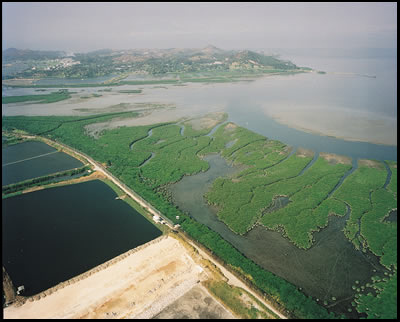Detailed studies of the rocks enable the geological history and the evolution of the tectonic setting to be deciphered. The large variety of rock types present in Hong Kong reflects the complexity of the geology of the region.
Geological History of Hong Kong
The geological history of Hong Kong has been strongly controlled by changes in the plate tectonic setting over the past 400 million years. Significantly, there are major gaps in the geological record in Hong Kong, which probably reflect major changes in the tectonic regime of the region. These have led to shifts in depositional environments ranging from rivers and deltas, to a warm shallow sea, to a deep continental sea, to a volcanically active continental margin, to an arid, block-faulted, continental terrestrial setting (Figure 1).
The oldest rocks in Hong Kong are of late Palaeozoic age and comprise non-marine and shallow marine sedimentary rocks. These Devonian, Carboniferous and Permian rocks crop out mainly in the northeast and northwest of Hong Kong.
The Mesozoic pre-volcanic sedimentary rocks comprise Early and Middle Jurassic sandstones, siltstones, and mudstones that were deposited in an alluvial, shallow marine, and sub-tidal environments.
Mesozoic volcanic and plutonic rocks are the dominant rock types in Hong Kong. They comprise granite plutons, rhyolitic dykes and thick rhyolitic tuffs and lavas. Most of the igneous rocks are of Late Jurassic to Early Cretaceous age.
Mesozoic sedimentary rocks, which are younger than the main volcanic episode, and Tertiary sedimentary rocks, are exposed mainly in northeastern Hong Kong. They comprise non-marine red bed and evaporitic sediments that were deposited in fault-controlled basins.
Weathering and erosion have shaped the present landscape of Hong Kong and led to the accumulation of locally thick Quaternary superficial deposits.
Tectonic Framework of Southeastern China
The unexposed (buried) continental basement of Hong Kong is thought to be older than 550 million years. However, in neighbouring Guangdong Province, crystalline rocks as old as 2.5 billion years have been discovered.
Southeastern China is believed to comprise a series of three old crustal blocks. These blocks are known as the North China Block, the Yangtze Block and the Cathaysia Block (Figure 2). The crustal blocks have been joined together (sutured) by continent - continent collision events over the past 1,000 million years.
The present-day tectonic setting of southeastern China is what is termed a passive continental margin (i.e. there is no plate boundary along the edge of the continental platform).
Southeastern China forms part of the Eurasian Plate, which is in continent-continent collision with the Indo-Australian Plate along its southern border (forming the Himalayan Mountain Chain).
In the east, the Philippine Plate is moving northwestwards forming a complex oceanic subduction zone system along the margin of the Eurasian Plate. North of Taiwan, the Philippine Plate is being subducted beneath the Eurasian Plate. South of Taiwan, both the Philippine and Eurasian Plates appear to be subducting beneath the islands of the Philippines, leading to a complex history of volcanism and earthquakes.
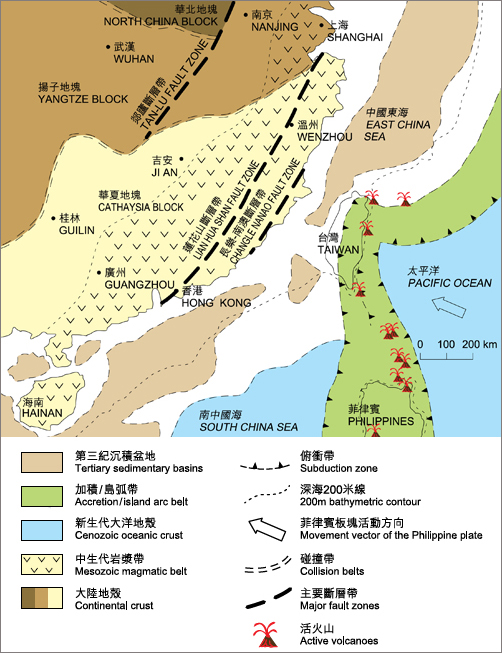
Figure 2: Crustal blocks and the present-day tectonic setting of southeastern China.
Palaeozoic to Mesozoic Pre-volcanic Period
About 1,000 million years ago, the continental basement of Hong Kong (the Cathaysia Block) collided with the Yangtze Block in a convergent margin tectonic setting.
By about 600 million years ago, a large part of southeastern China was submerged beneath a shallow continental sea.
By 400 million years ago, sediments from rivers and their deltas were being deposited in the Hong Kong region. These sediments now form the oldest rocks in Hong Kong, which are sedimentary rocks of the Devonian Bluff Head Formation. Tectonically, the area was relatively stable.
Devonian Bluff Head Formation – conglomerate and sandstone (around 410 to 360 million years ago)
Devonian rocks occur at two main locations in Hong Kong: on the northern shore of Tolo Channel and at Ma On Shan. They include layers of conglomerate and sandstone. Fragments of fossil fish (placoderm (Figure 3)) were discovered in 1980 in the sedimentary rock layers at Harbour Island and thus confirmed the Devonian age of the rocks. The Devonian conglomerates are white in colour and contain rounded pebbles of quartzite set in a matrix of coarse quartz-rich sand (Figure 4). The sediments were deposited in fluvial and deltaic environments.

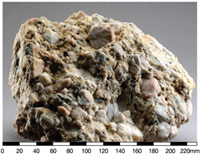
Over the following 50 to 70 million years, the area was submerged beneath a warm shallow sea in which calcareous muds were deposited. These deposits are preserved in Hong Kong as marble beneath Yuen Long.
By about 300 million years ago, the region had become a deep continental sea.
Carboniferous Yuen Long Formation – Marble (around 360 million years ago)
Marble occurs in the northwest New Territories. It is not exposed at the surface, but is buried beneath thick sediments on the Yuen Long Plain. The marble is metamorphosed limestone, which was originally deposited in a warm and shallow sea environment. Pure marble contains more than 95% crystalline calcite minerals that are readily dissolved by weakly acidic groundwater (Figure 5). Solution cavities occur in the marble, which have resulted in the development of a karst topography (now buried).
Carboniferous Lok Ma Chau Formation – Quartizite and graphite schist (around 340 million years ago)
The Lok Ma Chau Formation is distributed in the northern New Territories. It comprises mainly metamorphosed sedimentary rocks, including meta-conglomerate, meta-sandstone, meta-siltstone, quartzite and graphite schist. Quartzite is composed mainly of recrystallised quartz with some tiny flakes of sericite, mica. Graphite schist is dark black in colour and shows well developed metamorphic foliation (Figure 6). The sediments were deposited on a tidal flat or as a deltaic fan.
Marble & Skarn – Contact metamorphic rocks
Skarn (Figure 7) is a contact metamorphic rock formed by the alteration of carbonate-bearing sedimentary rocks (such as marble) adjacent to an igenous intrusion. It comprises calcium, magnesium and iron silicate minerals. The Ma On Shan iron ore is hosted in skarn rocks and contains iron- and magnesium-bearing minerals, such as magnetite and haematite.
Permian Tolo Harbour Formation – siltstone and mudstone (around 300 to 250 million years ago)
Rocks of Permian age are found in Tolo Harbour, mainly on Ma Shi Chau. They are greyish siltstones and mudstones (Figure 8) that contain pyrite minerals (iron sulphide). The sedimentary layers on Ma Shi Chau are commonly deformed by slump folding. Several marine fossils have been identified in the siltstones and mudstones, which have confirmed a Permian age for the rocks and indicate that the rocks were originally deposited in a near-shore tidal flat environment.

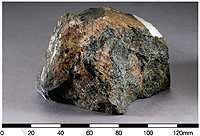

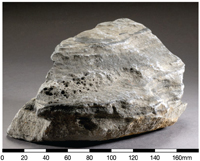
Between 250 and 200 million years ago, there was a major tectonic event in China, possibly resulting from major plate reorganisation. This was accompanied by the intrusion of granite magmas. The older rocks in Hong Kong were strongly deformed.
From about 200 to 80 million years ago, a convergent margin tectonic setting developed along the southeastern coast of China. In the Hong Kong region, active volcanoes erupted ash and lava between about 165 and 140 million years ago.
Early Jurassic Tolo Channel Formation – fossil-bearing siltstone and mudstone (around 200 to 190 million years ago)
Early Jurassic rocks occur as small exposures at Sham Chung, Fung Wong Wat and Tai Tong. They consist of grey to greyish white thinly bedded siltstone and mudstone (Figure 9) with lenses of sandstone. In 1924, the first fossil in Hong Kong, an ammonite (Hongkongites hongkongensis), was discovered embedded in the mudstone on the northern shore of Tolo Channel. This confirmed the age as Early Jurassic. The sediments were probably deposited in a shallow marine, sub-tidal environment.
Middle Jurassic Tai O Formation – sandstone and siltstone (around 190 to 180 million years ago)
The Tai O Formation is exposed along the coast from Tai O to Sham Wat Wan in the western part of Lantau Island. These sedimentary rocks include alternating layers of sandstone and siltstone (Figure 10) and show a variety of sedimentary structures such as cross bedding and shrinkage cracks. Plant fossils have also been found in the Tai O Formation, confirming the age as Middle Jurassic. The sediments were probably deposited on an alluvial plain.
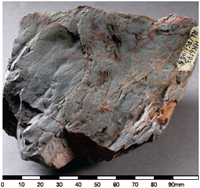
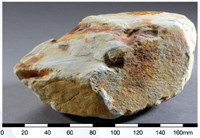
Mesozoic Volcanism and Plutonism
Evidence for the oldest volcanoes in Hong Kong occurs in the Tuen Mun area, where a relatively small volume of volcanic ash and lavas rich in calcium, sodium, iron, and magnesium aluminium silicate minerals are exposed. Preliminary radiometric dating of these rocks suggests that they are about 180 million years old. They probably represent the remnants of a chain of andesitic stratovolcanoes that developed along the southeastern coast of China after the onset of a convergent margin tectonic setting in the Early to Middle Jurassic Period (200 to 175 million years ago).
Middle Jurassic Tuen Mun Formation – andesite lava (around 180 million years ago)
The Tuen Mun Formation comprises andesitic volcanic rocks and volcaniclastic sedimentary rocks that are distributed along the Tuen Mun Valley. Andesite lava (Figure 11) is common in the upper part of the formation. The andesite is dark grey, very fine-grained and commonly shows metamorphic foliation. Sporadic epidote mineralisation gives the rock a greenish colour.
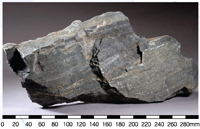
Figure 11: Andesite lava of
the Tuen Mun Formation
As the convergent margin matured, the subduction zone migrated southeastwards, and volcanoes of a slightly different type and composition soon developed. Volcanic ash and lava rich in dominantly silica (quartz), potassium, sodium and iron aluminium silicate minerals were erupted from large caldera-type volcanoes during the major period of volcanic activity that affected Hong Kong between 165 and 140 million years ago. Eruptions occurred in four distinct episodes (Figure 12): 165-160 million years, 148-146 million years, 143-142 million years and 140 millions years, and were accompanied by the intrusion of large granite plutons.
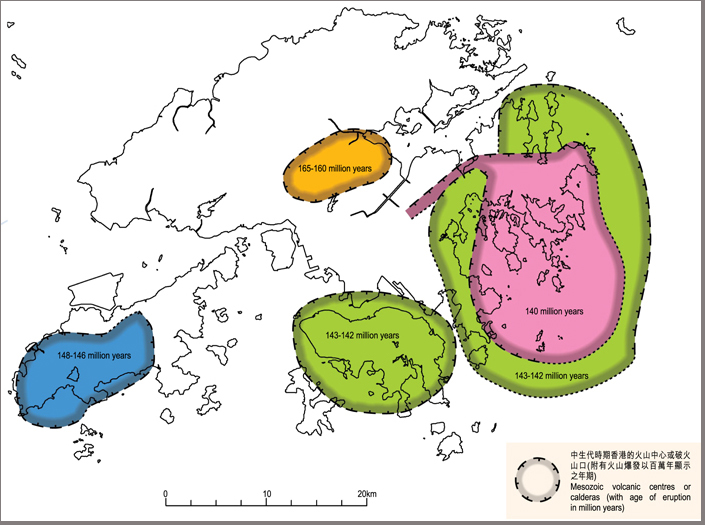
Figure 12: Inferred locations of the Mesozoic volcanic centres or calderas in Hong Kong.
Major Volcanic Episodes
165-160 million years
The first major episode of eruption formed much of the volcanic rock exposed in the central New Territories. These rocks are dominantly crystal-rich ashes containing abundant rock fragments. The volcanic eruptions were very violent, and there is very little evidence of any lava flows. Although the caldera that produced the ash has long since disappeared, its approximate location can be determined from the concentration of volcanic vent-type materials and the associated plutonic rocks. Volcanic vent materials and related plutonic bodies form a discontinuous, northeast-oriented ring-like structure that probably marks the original caldera boundary (Figure 13). Northeast-trending faults, subparallel to the convergent margin, probably controlled the shape and size of the caldera.
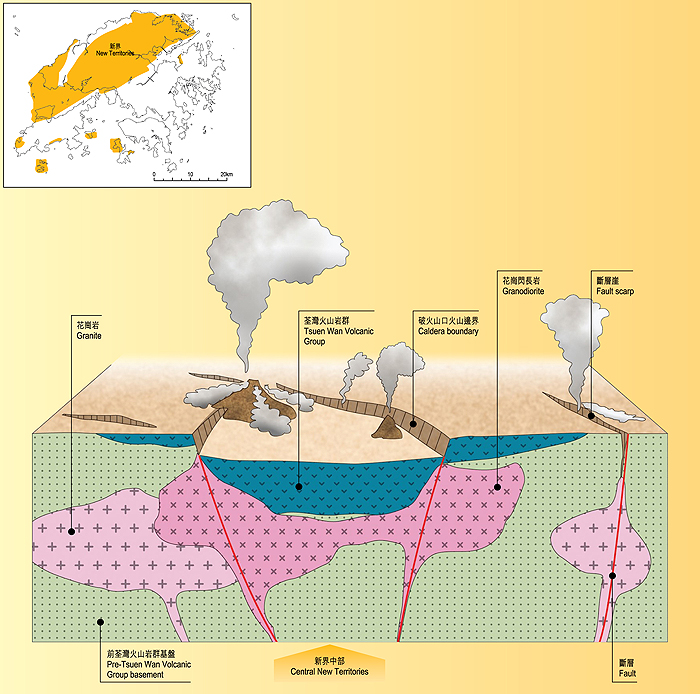
Figure 13: Schematic representation of caldera development and related subvolcanic intrusions between 165 to 160 million years ago (Insert map indicates the distribution of igneous rocks in Hong Kong associated with this volcanic episode).
Middle Jurassic Tsuen Wan Volcanic Group – coarse ash crystal tuff (164 to 160 million years ago)
The Tsuen Wan Volcanic Group is mainly exposed in the northeastern and northwestern New Territories. The dominant rock type is coarse ash crystal tuff (Figure 14), which is composed of crystal fragments of quartz, feldspar, hornblende and biotite, locally containing rock fragments. The volcanic ash was erupted from a nearby volcanic centre.
Middle Jurassic Tsuen Wan Volcanic Group – tuff breccia (164 to 160 million years ago)
Tuff breccia (Figure 15) at Shek Lung Kung comprises angular rock fragments that are up to 6 m in diameter. The rock fragments consist mainly of volcanic rocks with some quartzite and chert. The size and angularity of the fragments suggest that they were deposited close to a volcanic vent.
Middle Jurassic Lantau Granite – megacrystic medium-grained granite
The Lantau Granite (Figure 16) occurs mainly on Lantau Island, but can also be found as isolated outcrops in other places, such as Tuen Mun, the Soko Islands, and Lamma Island. The Lantau Granite is grey in colour and contains quartz, plagioclase feldspar and alkali feldspar in roughly equal proportions, as well as hornblende and biotite. The minerals are generally medium-grained, although very large crystals (megacrysts) (5–15 mm) of alkali feldspar are present, giving the rock what is termed a megacrystic texture.
Middle Jurassic Tai Po Granodiorite – porphyritic fine-grained granodiorite
The Tai Po Granodiorite (Figure 17) occurs mainly in the central New Territories and on Tsing Yi, and also as discontinuous outcrops in the central and southern parts of Hong Kong. The rock contains quartz, feldspar with subordinate biotite and hornblende minerals. The grain sizes of some of the crystals are relatively larger than that in the groundmass, giving the rocks an inequigranular (porphyritic) texture. Compared with granite, granodiorite contains slightly less quartz, and plagioclase is more dominant than alkali feldspar.
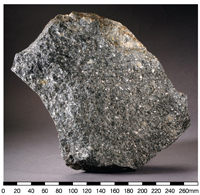
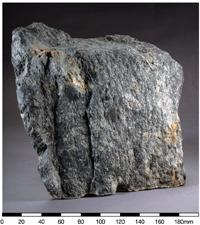
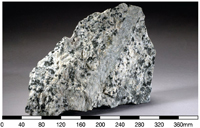
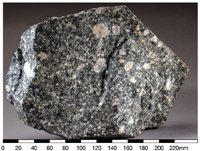
148-146 million years
Further migration of the convergent margin southeastward led to a shift in focus of volcanism towards the southeast and towards the development of stronger northwest-southeast tensional forces. A major new volcanic caldera developed in the area that is now the central part of Lantau Island (Figure 18). This caldera was fed from a deep magma chamber, with the magma injected along dykes. A granite body in the vicinity of Sha Tin represents the remnants of the magma chamber, while numerous east-northeast and northeast-trending dykes on northeast Lantau Island, Ma Wan and Tsing Yi represent the feeder dyke plumbing system of the volcano. Measurement of the width of the dyke complex suggests that approximately 6 km of northwest-southeast crustal extension took place over about 1.5 million years.
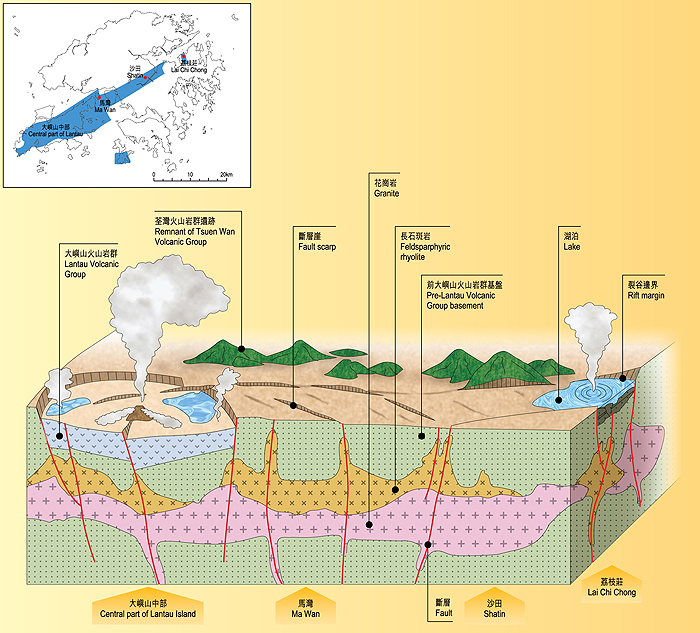
Figure 18: Schematic representation of caldera development and related subvolcanic intrusions between 148 to 146 million years ago (Insert map indicates the distribution of igneous rocks in Hong Kong associated with this volcanic episode).
Compared with the earlier volcanic episode, the volcanic activity appears to have been hotter, less crystal-rich, and more violent. In places, the volcanic ash was so hot that it fused together to form lava. This process, called welding, is thought to be the origin of some of the banded volcanic rocks on Lantau Island.
Late Jurassic Lantau Volcanic Group – rhyolite lava and tuff (148 to 146 million years ago)
The Lantau Volcanic Group is exposed on Lantau Island and at Lai Chi Chong. The volcanic rocks on Lantau Island (Figure 19) general contain crystals of quartz and feldspar and display distinct flow structures. They were eitehr erupted as viscous lava flows, or as thick and densely welded volcanic ash flows. The volcanic ash flows were probably derived from explosive volcanic eruptions associated with the collapse of a caldera.
Late Jurassic Lantau Volcanic Group – volcaniclastic rocks (148 to 146 million years ago)
Volcaniclastic rocks (Figure 20) comprising well-bedded layers of tuffaceous mudstone, cherty siltstone, sandstone, conglomerate and tuff occur at Lai Chi Chong. Soft sediment deformation structures and flame structures are common. These volcanic sediments were probably deposited rapidly from debris flows onto unconsolidated sediments within a lake that occupied a volcanic depression.
Late Jurassic Needle Hill Granite – porphyritic fine-grained granite
The Needle Hill Granite (Figure 21) forms a northeast-trending elliptical intrusive body on the northwestern side of the Shing Mun Valley. The granite is light pinkish grey in colour and has a porphyritic texture. It contains relatively large crystals of quartz and plagioclase feldspar set in granular fine-grained groundmass.
Late Jurassic Lantau Dyke Swarm – feldsparphyric rhyolite
On northern Lantau Island and Tsing Yi, feldsparphyric rhyolite dykes occur in a swarm comprising numerous sub-parallel intrusions. The most distinctive feature of the dykes is the presence of large tabular-shaped feldspar crystals that are set in very fine-grained dark groundmass (porphyritic texture) (Figure 22). The large crystals, known as phenocrysts, range from 10 to 30 mm in length. The chemical composition of these dykes is similar to granite.
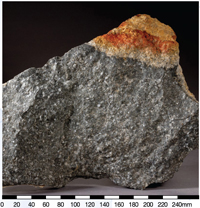

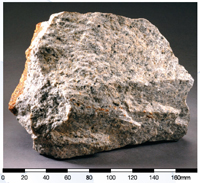
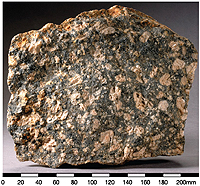
143-142 million years
The scale and intensity of Mesozoic volcanic activity continued to increase as the convergent margin migrated southeastwards. The third major episode of volcanic activity in the Hong Kong region is particularly complex, with the formation of at least two calderas that each erupted volcanic materials of slightly different compositions. Evidence suggests that one caldera, centred on Hong Kong Island, erupted volcanic ash with very little crystal content, while the other caldera, centred in the area of Sai Kung and Long Harbour, erupted volcanic ash with abundant crystal content (Figure 23).
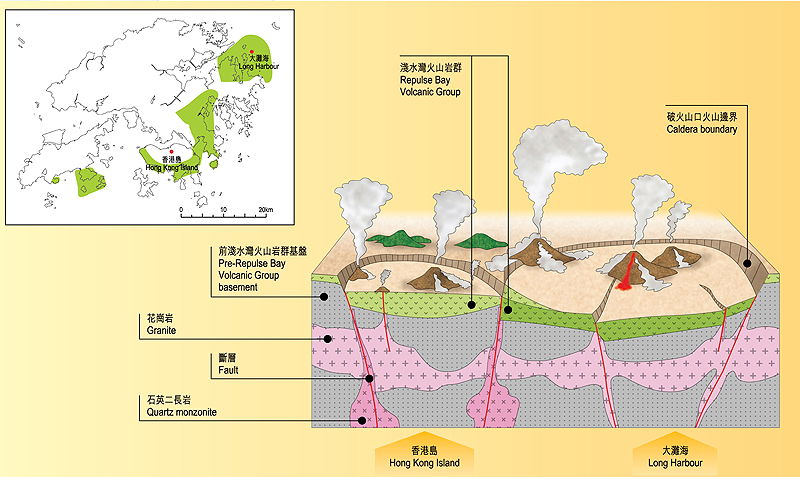
Figure 23: Schematic representation of caldera development and related subvolcanic intrusions between 143 to 142 million years ago (Insert map indicates the distribution of igneous rocks in Hong Kong associated with this volcanic episode).
The two volcanoes probably erupted simultaneously for a period. Very little lava appears to have been erupted from either volcano. Over time, the volcanic eruptions became hotter and increasingly more violent. Both volcanoes probably culminated in caldera collapse following a catastrophic eruption. Today, the caldera margins are marked by discontinuous dyke-like intrusions of plutonic rock.
Early Cretaceous Repulse Bay Volcanic Group – eutaxitic fine ash vitric tuff (143 to 142 million years ago)
The Repulse Bay Volcanic Group is exposed in southern Hong Kong Island, eastern Kowloon and Sai Kung. One of the major rock types of the volcanic group is fine ash vitric tuff which commonly displays a eutaxitic foliation (Figure 24). Eutaxitic foliation is a welding structure that forms when hot pumice (volcanic glass of rhyolitic composition) is fused, compressed and consequently oriented in the volcanic rock. The welding structure suggests that the volcanic ash was extremely hot during deposition.
Early Cretaceous Repulse Bay Volcanic Group – coarse ash crystal tuff (143 to 142 million years ago)
Coarse ash crystal tuff is the other major rock type of the Repulse Bay Volcanic Group. In Long Harbour (Tai Tan Hoi), the tuff (Figure 25) contains crystal fragments of quartz, pink feldspar and biotite minerals, and some rock fragments. Welding structures can be seen in the volcanic rocks. The volcanic group was probably formed by periodic eruptions from a caldera-type volcano at around 143 million years ago.
Early Cretaceous Tong Fuk Quartz Monzonite – porphyritic quartz monzonite
Quartz monzonite (Figure 26) on Lantau Island is pinkish grey, and porphyritic fine-grained, containing large crystals of feldspar. Quartz monzonite is an intrusive igneous rock containing approximately equal amounts of plagioclase feldspar and alkali feldspar, and a small amount of quartz. Dark coloured minerals, such as biotite and hornblende are also found in the rocks. The quartz monzonite magma probably originated from a deep part of the Earth's crust and intruded along well-defined conduits (such as faults).
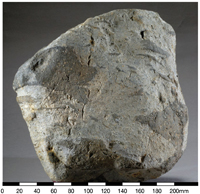
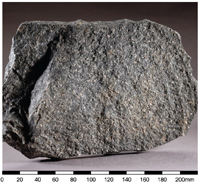
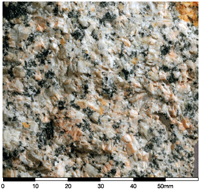
140 million years
The fourth and final episode of volcanic activity in Hong Kong is marked by the development of a large caldera volcano centred in the Rocky Harbour area, which was fed from northeast-trending fissure dykes along its northern and southern margins (Figure 27). Eruptions were dominated by large volumes of crystal-poor volcanic ash that accumulated as thick layers, which are, in places, strongly fused together. Fusing indicates that the eruptions were extremely hot.

Figure 27: Schematic representation of caldera development and related subvolcanic intrusions 140 million years ago (Insert map indicates the distribution of igneous rocks in Hong Kong associated with this volcanic episode).
The tectonic setting of Hong Kong appears to have been strongly back-arc extensional as the convergent margin continued to shift farther southeastwards. The final volcanic episode culminated with one extremely explosive eruption associated with caldera collapse. Following the caldera collapse, an enormous volume of ash, with a minimum thickness of 400 metres, accumulated in the volcanic depression. The ash slowly cooled to form the spectacular six-sided columns of rock seen at the East Dam of High Island Reservoir. This cataclysmic eruption marked the end of Mesozoic volcanism as recorded in the Hong Kong region.
Early Cretaceous Kau Sai Chau Volcanic Group – rhyolite lava and tuff (141 to 140 million years ago)
Rhyolite lava (Figure 28) and tuff of the Kau Sai Chau Volcanic Group is present in Sai Kung East Country Park and on the Clear Water Bay Peninsula. The volcanic rock is dark grey, very fine-grained with tabular shaped feldspar crystals and commonly shows flow banding. Flow banding was created by the laminar flow of a viscous magma and/or densely welded volcanic ash across the ground surface. The lava and volcanic ash were probably erupted from a fissure-like volcano located along a fault.
Early Cretaceous Kau Sai Chau Volcanic Group – fine ash vitric tuff (141 to 140 million years ago)
At High Island and on the Ninepin Islands, fine ash vitric tuff of the Kau Sai Chau Volcanic Group (Figure 29) is present in the form of hexagonal columns. The tuff is slightly reddish in colour, very fine-grained and contains crystal fragments of pink feldspar. These columns were developed when the hot volcanic ash was ponded, cooled and contracted. The volcanic rocks were probably formed from a very explosive eruption of a large caldera-type volcano about 140 million years ago.
Early Cretaceous Kowloon Granite – equigranular medium-grained granite
The Kowloon Granite (Figure 30) forms a roughly circular intrusive body centred on Victoria Harbour. The granite is generally medium-grained equigranular (i.e. crystals are of roughly equal grain size ranging between 1 to 3 mm) and has a pinkish grey colour. It contains quartz, plagioclase feldspar, alkali feldspar and biotite.
Pegmatite
Pegmatite (Figure 31) occurs in dykes, lenses or veins near the margins of granitic intrusions. It comprises a very coarse-grained igneous rock with individual crystals up to 20 mm in size. The constituent minerals are mainly feldspar, quartz and muscovite, but may also include pyrite and chlorite.

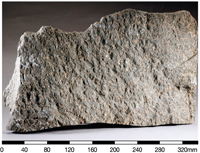
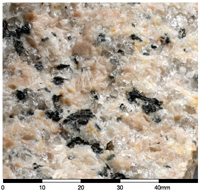

Aplite
Aplite is a very fine-grained granitic rock that generally occurs as veins and dykes in granitic rocks (Figure 32). The grain size of individual minerals is generally less than 1 mm, and the rock shows a sugary texture.
Greisenised granite
Greisenised granite (Figure 33) has an average grain size of 1 mm and exhibits a sugary texture. It comprises mainly quartz and muscovite, which gives it a shiny appearance. Near Devil's Peak in eastern Kowloon, fine-grained granite has been altered to greisenised granite by hot and mineral-rich fluid (metasomatism).
Mafic and intermediate dykes
Mafic and intermediate dykes (Figure 34) are widespread throughout Hong Kong. They are dark grey in colour and generally form narrow dykes of basaltic andesite less than 1m wide. Geochemically, they contain significantly less silica (SiO2) than the granitic rocks.
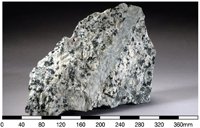
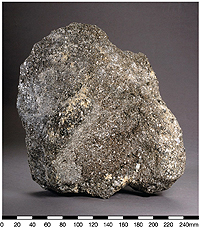
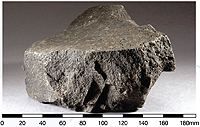
Mesozoic Post-volcanic and Cenozoic Period
Between about 140 and 50 million years ago, the Hong Kong region was part of a landmass. Tectonically, the region was relatively stable, except for the development of several block-faulted basins. The climate was hot and dry.
Early Cretaceous Pat Sin Leng Formation – conglomerate, sandstone and siltstone (around 140 to 100 million years ago)
The Pat Sin Leng Formation conglomerate occurs in the northeastern New Territories where it forms a prominent south facing escarpment, the Pat Sin Leng. The conglomerate is greyish white in colour, and comprises subrounded pebbles of volcanic rocks, mudstone and reddish sandstone. The siltstone (Figure 35) is reddish purple in colour, and is thinly bedded. These pebbles were originally deposited in river channels soon after the cessation of volcanic activity in Hong Kong during the Early Cretaceous.
Late Cretaceous Port Island Formation – conglomerate and sandstone (around 100 million years ago)
On Port Island, reddish brown layers of conglomerate and sandstone occur (Figure 36). Cross-bedding, created by water currents, is developed in the sandstone. The sediments were probably deposited in river channels.
Late Cretaceous Kat O Formation – breccia (around 100 million years ago)
The Kat O Formation is exposed on several scattered outlying islands in the northeastern New Territories, including Crooked Island and Ap Chau. It comprises a sequence of breccia (Figure 37), conglomerate, sandstone and siltstone, cemented by calcite minerals. The colour of the sedimentary rocks varies from reddish brown to greyish white. The sediments were probably eroded from a fault scarp and deposited as an alluvial fan.
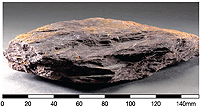
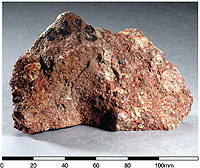

Eocene Ping Chau Formation – siltstone (around 50 million years ago)
The Ping Chau Formation, which is the youngest rock formation in Hong Kong, comprises thin layers of siltstone (Figure 38), which are gently inclined towards the northeast. Fossil insects as well as bituminised plant fragments have been discovered in the sedimentary rocks. The sediments were originally deposited within a lake that periodically dried up allowing salt crystals (gypsum) to form. However, the salt crystals (gypsum) were later dissolved, leaving behind only the moulds of the original crystals of gypsum in the siltstone. These moulds were subsequently filled by secondary minerals, including aegirine, calcite, zeolite and acmite minerals.
Eocene Ping Chau Formation – cherty siltstone (around 50 million years ago)
A layer of cherty siltstone (up to 1.2 m thick) is well exposed at Lung Lok Shui on the western coast of Ping Chau. Cherty siltstone (Figure 39) contains very fine-grained crystalline silica. It is a very strong rock resistant to weathering and erosion.
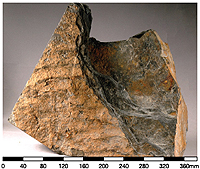
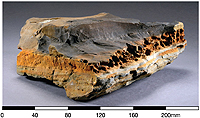
From 50 million years to about 2 million years ago, there is no record of any sediments being deposited in the Hong Kong region. However, there is strong evidence that this period was one of continued subtropical weathering. The granitic rocks, which had been emplaced about 2 kilometres below the ground surface, had largely been exposed, and were weathered to produce the thick (up to 250 metres) weathering profiles seen today.
From about 5 million years ago to the present, the Eurasian Plate has been in collision with the Philippine Plate, resulting in reactivation of northeast-trending faults in southeastern China.
Quaternary Period
The Quaternary Period, which extends from about 2.6 million years ago to the present-day, is characterised by cyclical climatic changes, during which world sea level periodically fell and rose in response to glacial and interglacial episodes.
During the cooler glacial periods, when sea level was as much as 120 metres lower than today, the coastline was about 100 kilometres south of Hong Kong and large volumes of alluvium were deposited on the exposed areas of former seabed.
Intervening periods of climatic warming led to melting of the ice sheets, which caused the sea level to rise during these interglacial periods. The rising sea flooded across the alluvial sediments, depositing marine mud over much of Hong Kong waters, with coarser, more sandy sediments accumulating in areas of strong tidal currents.
Thus, although Hong Kong was never covered by glacial ice, the stratigraphy of the offshore sediments provides indirect evidence of the major fluctuations in global climate over the Quaternary period.
Following the end of the last glacial period, about 11,000 years ago, sea level began to rise rapidly, probably reaching its present height in the Hong Kong region about 8,000 years ago.
Quaternary superficial deposits in Hong Kong primarily consist of hillslope deposits (colluvium), river deposits (alluvium), and offshore deposits (mud and sand). About 14% of the land surface of Hong Kong is covered by Quaternary deposits greater than 2 m thick. Man-made deposits, such as reclamations, constitute about 6% of the present land area of Hong Kong (1,105 km2).
Onshore Superficial Deposits
Colluvium
A layer of colluvium blankets most of the hillslopes, although in many areas it is very thin (less than 1 m thick). Colluvium comprises a range of grain sizes from fine-grained silt and sand washed down slopes by water, to coarse accumulations of large boulders deposited by landslides (Figure 40). Only deposits of colluvium greater than 2 m thick have been mapped on the Hong Kong Geological Survey maps. These thicker deposits mostly occur on the footslopes.
Colluvium is relatively thick over the granitic rocks, where it is derived from the deep weathered profiles. Colluvium is relatively thin over the volcanic rocks, which have shallow weathered profiles. Colluvium forms extensive deposits at the base of several large hill masses, such as the Lion Rock ridge, the Mid-levels area, the slopes of Fei Ngo Shan, below Castle Peak, Tai Mo Shan, and on Lantau Island.
Alluvium
Alluvium fills most of the stream and river valleys in Hong Kong. Relatively thin, narrow deposits occupy the hillside tributaries, and thicker, more extensive deposits floor the lowland valleys (Figure 41).
Alluvium generally comprises coarse-grained sands and gravels in the river channels and point bars, and fine-grained sediments on the floodplains. Alluvium forms distinctive dendritic patterns on the geological maps of Hong Kong.
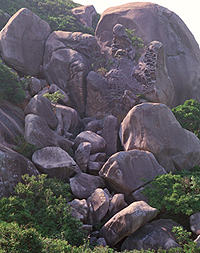
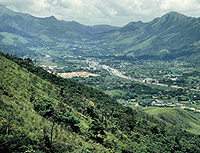
Offshore Superficial Deposits
The seabed in Hong Kong slopes gently to the south and southeast, and is generally covered with a layer of marine mud. The blanket of marine mud has accumulated since the rapid post-glacial rise in sea level that commenced approximately 11,000 years ago. The marine mud overlies older, mostly alluvial, sediments that were deposited by rivers when the sea level was lower.
Sand occurs on the seabed in areas where tidal currents prevent the finer sediments settling. These areas include tidal channels and the gaps between islands. Sand also occurs in the coastal zone where wave action has created beaches and sandbars.
Several wide tidal inlets, such as in Deep Bay (Figure 42) and at Starling Inlet, have accumulations of intertidal mud that is covered with mangroves.
